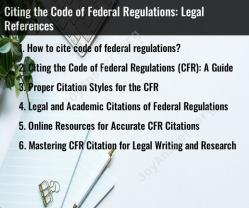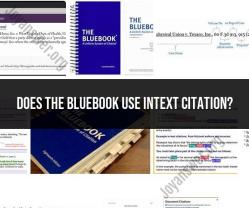Does the Bluebook use intext citation?
The Bluebook, which is a widely used guide for legal citation in the United States, primarily focuses on citation in legal documents such as law review articles, court documents, and legal memoranda. It does not use traditional in-text citations like those commonly found in academic papers and other non-legal publications.
Instead, the Bluebook provides a system of legal citation that relies on a combination of footnotes and citations within the text. In legal writing, when you reference a legal source, you typically use a footnote or endnote to provide a full citation to the legal authority or source. These footnotes or endnotes are placed at the bottom of the page or at the end of the document and are used to give readers detailed information about the cited source.
The text of a legal document generally does not contain in-text citations in the same way that you would find them in academic or non-legal writing, where author-date or author-page citations are commonly used. Instead, legal writers use a system of numbered footnotes or citations to provide references to legal authorities, cases, statutes, regulations, and other sources.
It's important to note that legal citation practices can vary by jurisdiction and publication, so if you are working on legal writing or research, it's essential to adhere to the specific citation style and guidelines required by the court, publication, or organization you are writing for. The Bluebook is just one of several citation guides used in legal writing, and it provides detailed rules for citing legal sources in a specific format.
Citing Sources: Does the Bluebook Include In-Text Citations?
Yes, the Bluebook does include in-text citations. In-text citations are placed within the body of your writing to indicate where you have obtained information or ideas from other sources. They are also used to give credit to the authors of those sources.
The Bluebook uses a parenthetical citation system for in-text citations. This means that the citation is placed within parentheses at the end of the sentence or clause where the information or idea is introduced.
The Bluebook and Citation Style: Understanding Proper Legal Referencing
The Bluebook is a legal citation style guide that is used by lawyers, judges, and law students. It provides detailed instructions on how to cite a variety of legal sources, including cases, statutes, regulations, and secondary sources.
The Bluebook is a complex document, but it is important to understand the basics of legal citation if you are writing about legal topics. Proper legal citation helps to ensure that your work is credible and well-researched.
Mastering Legal Citation: Navigating In-Text Citations with the Bluebook
The Bluebook provides detailed instructions on how to format in-text citations for a variety of legal sources. Here is a brief overview of the most common types of in-text citations:
- Case citations: Case citations include the name of the case, the court that decided the case, the volume and page number of the case report, and the year the case was decided. For example:
(Roe v. Wade, 410 U.S. 113 (1973))
- Statute citations: Statute citations include the title of the statute, the code section or section number, and the year the statute was enacted. For example:
(42 U.S.C. § 1983 (2023))
- Regulation citations: Regulation citations include the title of the code of federal regulations (CFR), the part number, and the section number of the regulation. For example:
(42 C.F.R. § 447.15 (2023))
- Secondary source citations: Secondary source citations include the name of the author, the title of the work, the volume and page number of the work, and the year the work was published. For example:
(Linda H. Edwards, Legal Writing and Analysis 16 (4th ed. 2015))
The Bluebook also provides instructions on how to format in-text citations for multiple sources, quoted material, and citations within citations. For more detailed information, please consult the Bluebook itself.
Conclusion
In-text citations are an important part of legal writing. The Bluebook provides detailed instructions on how to format in-text citations for a variety of legal sources. By following the instructions in the Bluebook, you can ensure that your legal writing is properly cited and credible.



